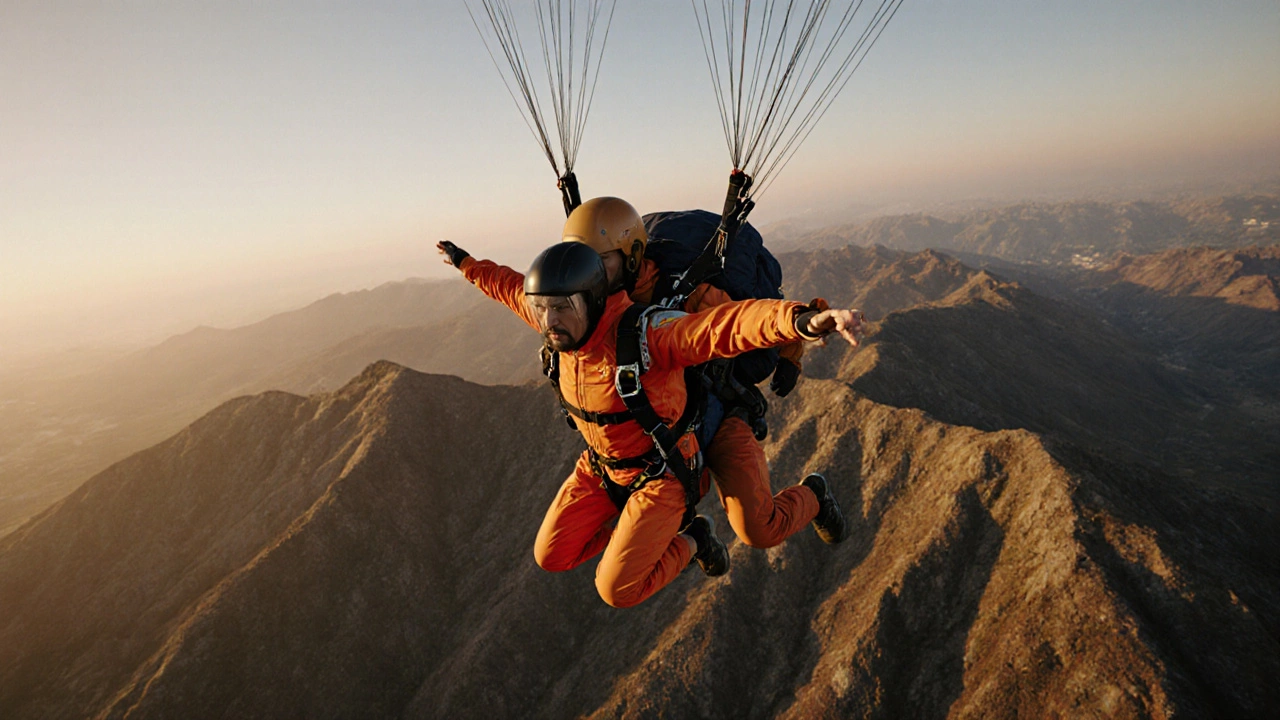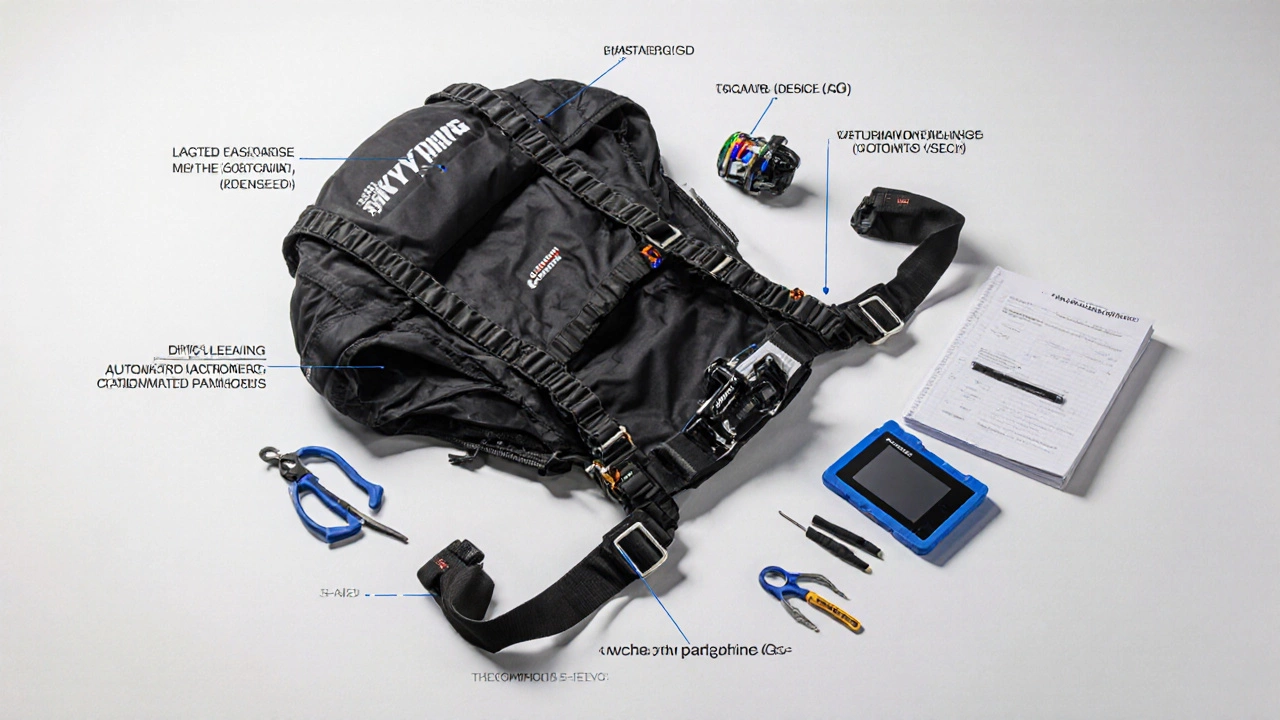What Is the Fatality Rate of Skydiving in India?

- Nov, 21 2025
- 0 Comments
- Aaron Blackwood
When you think of skydiving in India, you picture freefall over the Aravalli Hills, the Thar Desert, or the misty mountains of Himachal Pradesh. The thrill is real. But so is the question: how dangerous is it really? People ask this before they book, before they sign the waiver, before they climb into that plane. The answer isn’t a scary number-it’s a clear picture of risk, training, and safety standards.
Skydiving Fatality Rate: The Real Numbers
In the United States, the United States Parachute Association (USPA) reports about 0.39 deaths per 100,000 jumps. That’s less than 1 in 250,000 jumps. India doesn’t publish official national statistics, but based on data from licensed drop zones like those in Pune, Narnaul, and Goa, the fatality rate is in the same range-roughly 0.3 to 0.5 deaths per 100,000 jumps. That means if you made 100,000 skydives, you’d have a 99.97% chance of walking away unharmed.
Compare that to driving. In India, over 150,000 people die in road accidents every year. The chance of dying in a car crash on a daily commute is about 1 in 10,000 over a lifetime. Skydiving, even in a developing country, is statistically safer than driving to the grocery store.
Why Are Skydiving Fatalities So Rare?
Modern skydiving isn’t what you see in old movies. It’s not about jumping out of a plane with a basic parachute and hoping for the best. Today’s gear is packed with technology. Every tandem rig-used in 95% of first-time jumps in India-has a main parachute, a reserve parachute, and an automatic activation device (AAD). The AAD fires the reserve if the jumper is falling too fast and too low, even if they’re unconscious.
Drop zones in India that are licensed by the Aero Club of India (ACI) follow strict safety protocols. Instructors must have at least 500 jumps before teaching. Most have over 1,000. Equipment is inspected after every 100 jumps or every 6 months-whichever comes first. Parachutes are repacked by certified riggers using digital logs. There’s no room for guesswork.
Weather matters too. Skydiving in India is only allowed in clear conditions. Winds over 15 km/h? Cancelled. Cloud cover below 3,000 feet? Cancelled. Thunderstorms? Absolutely not. Operators don’t risk it. One bad jump can shut down a business.
Who Gets Hurt? The Real Causes
When fatalities do happen, they’re almost never due to equipment failure. Between 2018 and 2024, only one recorded incident in India involved a main parachute malfunction. The rest? Human error.
- **Poor landing technique**-jumpers who panic and don’t follow instructor cues
- **Altitude awareness**-not pulling at 4,000 feet, especially in high-altitude locations like Manali
- **Ignoring training**-not listening to the 15-minute safety briefing
- **Jumping under the influence**-a few cases involved alcohol the night before
One incident in 2022 near Pune involved a jumper who tried to flip mid-air to take a selfie. He lost control, didn’t deploy the parachute in time, and died. That’s not a gear failure. That’s a choice.

How India Compares to Global Standards
India’s skydiving scene is smaller than the U.S. or Europe, but the safety culture is catching up. Drop zones like Skydive India (Pune), Skydive Goa, and Skydive Narnaul are ISO-certified. They use gear from manufacturers like PD (Performance Designs) and Sunward, the same brands used in Australia and Canada.
Compare that to countries with less regulation. In some parts of Southeast Asia, unlicensed operators offer cheap jumps with outdated gear. India doesn’t have that problem-at least not at reputable centers. The Aero Club of India shuts down operators who cut corners. If a drop zone isn’t on the ACI list, don’t jump there.
What You Can Do to Stay Safe
You can’t control the gear. But you can control your choices.
- **Only book with ACI-licensed drop zones.** Ask for their license number. Verify it on the Aero Club of India’s website.
- **Ask about instructor experience.** A good instructor will tell you their jump count. If they hesitate, walk away.
- **Listen to the briefing.** Seriously. It’s not a formality. It’s your lifeline.
- **Don’t drink the night before.** Even one drink affects your reaction time.
- **Wear proper gear.** No sandals, no loose clothing. The harness is designed for safety-not fashion.
Also, avoid off-season jumps. Monsoon season (June-September) isn’t just rainy-it’s unpredictable. Wind patterns shift. Visibility drops. Most operators shut down during this time for a reason.

Is Skydiving Worth the Risk?
Let’s put it this way: you’re more likely to die from a bee sting in India than from skydiving. You’re more likely to die from falling off a ladder while cleaning your roof. You’re more likely to die from a heart attack while watching a football match.
Skydiving isn’t about defying death. It’s about experiencing life in a way most people never will. The silence after the freefall. The view of the Earth curving below. The calm when the parachute opens. That moment stays with you forever.
Yes, there’s risk. But it’s a managed risk. A calculated one. And for the thousands who jump safely every year in India, it’s worth every second.
Frequently Asked Questions
What is the fatality rate of skydiving in India?
The fatality rate in India is estimated at 0.3 to 0.5 deaths per 100,000 jumps. This matches global safety standards. Most incidents are due to human error, not equipment failure. Licensed drop zones maintain rigorous safety protocols.
Is skydiving safer than driving in India?
Yes. The chance of dying in a road accident in India is about 1 in 10,000 over a lifetime. Skydiving’s fatality rate is roughly 1 in 250,000 jumps. Statistically, skydiving is far safer than your daily commute.
Are tandem jumps safe for beginners?
Tandem jumps are the safest way to skydive. You’re strapped to a certified instructor with over 1,000 jumps. The equipment includes a main chute, a reserve chute, and an automatic activation device. Over 95% of first-time jumps in India are tandem.
Which are the safest skydiving locations in India?
Pune, Narnaul, and Goa have the most reputable drop zones. All are licensed by the Aero Club of India and use modern gear. Avoid unlicensed operators in remote areas-even if they offer lower prices.
Can weather affect skydiving safety in India?
Yes. Wind speeds above 15 km/h, low cloud cover, or thunderstorms lead to cancellations. Reputable operators prioritize safety over profit. If they cancel, trust them. Monsoon season (June-September) is not ideal for skydiving anywhere in India.